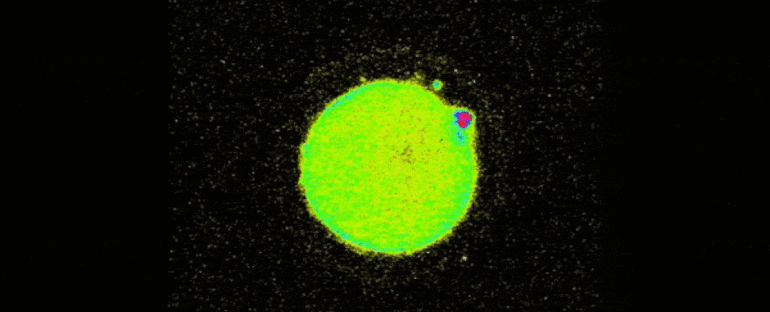New life quite literally sparks into being, at least under fluorescence microscopy. That moment when sperm touches egg, billions of zinc atoms ignite across their now conjoined surfaces.
This spectacular but minuscule phenomenon was first witnessed in human fertilization back in 2016.
“It was remarkable,” said medical researcher Teresa Woodruff from Northwestern University, at the time. “We discovered the zinc spark just five years ago in the mouse, and to see the zinc radiate out in a burst from each human egg was breathtaking.” (Woodruff is now at Michigan State University.)
Now researchers have discovered this chemistry of conception may be a conserved feature of fertilization in vertebrates, or animals with backbones.
The dramatic flash of fertilization in human eggs. (Northwestern University)
As well as within humans and mice (Mus musculus), these zinc fireworks have been observed in fertilized macaque and cow (Bos taurus) eggs. And a new study just witnessed this zinc explosion in the African clawed frog (Xenopus laevis), too, which means the phenomenon is at least as old as when frogs and mammalian ancestors parted evolutionary ways, around 300 million years ago.
As the zinc explodes out across an egg under study, it binds to molecular labels in a reaction that causes them to fluoresce in a blazing flash of light under a fluorescence microscope (as seen above).
Northwestern biochemist John Seeler and colleagues chose to look at these biochemical sparks in the African clawed frog because of their size and abundance.
“The diameter of Xenopus eggs is 15 times that of mouse eggs, allowing for a more in-depth study of the dynamics of the zinc efflux,” the team wrote in their paper.

Using powerful imaging technology like X-ray fluorescence microscopy and electron microscopy, the interdisciplinary team was able to see how the eggs stored zinc in microscopic storage compartments along its surface. They measured that these storage vesicles have 10 times the zinc found in the rest of the egg – ready to explode in response to fertilization.
The researchers also detected a huge release of manganese alongside the zinc in the frog eggs, which has not been seen in any of the other animals. They now hope to check manganese levels in mice.
“We often think of genes as key regulating factors, but our work has shown that atoms like zinc and manganese are critical to the first steps in development after fertilization,” said Woodruff about the new study.

Research in mice indicates the fluctuating zinc serves several purposes. It switches the cell cycle in the egg from meiotic – involving cell division that results in sex cells with only half a set of chromosomes – to mitotic – that produces cells with a full set of chromosomes. This allows the egg to start developing into an embryo.
The zinc also creates a physiological block to stop other sperm from joining the party. The same appears to be true for the manganese as Seeler and team showed both elements inhibit fertilization when around the egg.
The size of the zinc sparks also reveals the quality of the resulting embryo, an incredibly useful indicator for in vitro fertilization (IVF).
“This work may help inform our understanding of the interplay of dietary zinc status and human fertility,” said Michigan State University molecular biologist Thomas O’Halloran. “[It supports] an emerging picture that transition metals are used by cells to regulate some of the earliest decisions in the life of an organism.”
Their research was published in Nature Chemistry.



